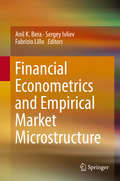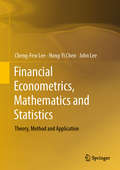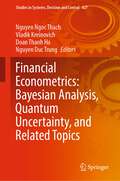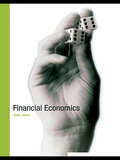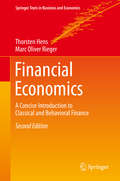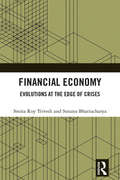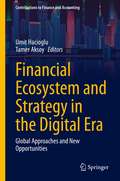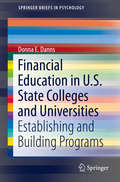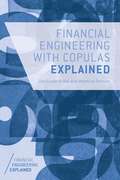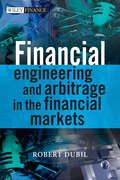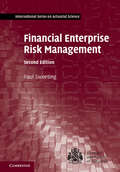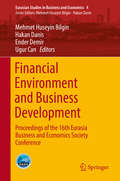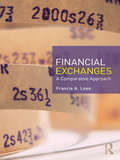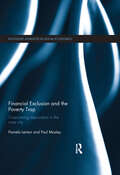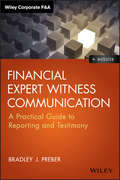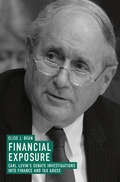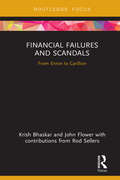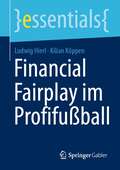- Table View
- List View
Financial Econometrics Modeling: Market Microstructure, Factor Models and Financial Risk Measures
by Greg N. Gregoriou Razvan PascalauThis book proposes new methods to build optimal portfolios and to analyze market liquidity and volatility under market microstructure effects, as well as new financial risk measures using parametric and non-parametric techniques. In particular, it investigates the market microstructure of foreign exchange and futures markets.
Financial Econometrics and Empirical Market Microstructure
by Anil K. Bera Sergey Ivliev Fabrizio LilloIn the era of Big Data our society is given the unique opportunity to understand the inner dynamics and behavior of complex socio-economic systems. Advances in the availability of very large databases, in capabilities for massive data mining, as well as progress in complex systems theory, multi-agent simulation and computational social science open the possibility of modeling phenomena never before successfully achieved. This contributed volume from the Perm Winter School address the problems of the mechanisms and statistics of the socio-economics system evolution with a focus on financial markets powered by the high-frequency data analysis.
Financial Econometrics, Mathematics and Statistics: Theory, Method and Application
by John Lee Cheng-Few Lee Hong-Yi ChenThis rigorous textbook introduces graduate students to the principles of econometrics and statistics with a focus on methods and applications in financial research. Financial Econometrics, Mathematics, and Statistics introduces tools and methods important for both finance and accounting that assist with asset pricing, corporate finance, options and futures, and conducting financial accounting research. Divided into four parts, the text begins with topics related to regression and financial econometrics. Subsequent sections describe time-series analyses; the role of binomial, multi-nomial, and log normal distributions in option pricing models; and the application of statistics analyses to risk management. The real-world applications and problems offer students a unique insight into such topics as heteroskedasticity, regression, simultaneous equation models, panel data analysis, time series analysis, and generalized method of moments. Written by leading academics in the quantitative finance field, allows readers to implement the principles behind financial econometrics and statistics through real-world applications and problem sets. This textbook will appeal to a less-served market of upper-undergraduate and graduate students in finance, economics, and statistics.
Financial Econometrics: Bayesian Analysis, Quantum Uncertainty, and Related Topics (Studies in Systems, Decision and Control #427)
by Vladik Kreinovich Nguyen Ngoc Thach Nguyen Duc Trung Doan Thanh HaThis book overviews latest ideas and developments in financial econometrics, with an emphasis on how to best use prior knowledge (e.g., Bayesian way) and how to best use successful data processing techniques from other application areas (e.g., from quantum physics). The book also covers applications to economy-related phenomena ranging from traditionally analyzed phenomena such as manufacturing, food industry, and taxes, to newer-to-analyze phenomena such as cryptocurrencies, influencer marketing, COVID-19 pandemic, financial fraud detection, corruption, and shadow economy. This book will inspire practitioners to learn how to apply state-of-the-art Bayesian, quantum, and related techniques to economic and financial problems and inspire researchers to further improve the existing techniques and come up with new techniques for studying economic and financial phenomena. The book will also be of interest to students interested in latest ideas and results.
Financial Econometrics: Models and Methods
by Oliver LintonThis is a thorough exploration of the models and methods of financial econometrics by one of the world's leading financial econometricians and is for students in economics, finance, statistics, mathematics, and engineering who are interested in financial applications. Based on courses taught around the world, the up-to-date content covers developments in econometrics and finance over the last twenty years while ensuring a solid grounding in the fundamental principles of the field. Care has been taken to link theory and application to provide real-world context for students. Worked exercises and empirical examples have also been included to make sure complicated concepts are solidly explained and understood.
Financial Economics
by Chris JonesWhilst many undergraduate finance textbooks are largely descriptive in nature, the economic analysis in most graduate texts is too advanced for latter year undergraduates. This book bridges the gap between these two extremes, offering a textbook that studies economic activity in financial markets, focusing on how consumers determine future consumption and on the role of financial securities. Areas covered in include: an examination of the role of finance in the economy using basic economic principles, eventually progressing to introductory graduate analysis a microeconomic study of capital asset pricing when there is risk, inflation, taxes and asymmetric information an emphasis on economic intuition using geometry to explain formal analysis an extended treatment of corporate finance and the evaluation of public policy.
Financial Economics
by Thorsten Hens Marc Oliver RiegerFinancial economics is a fascinating topic where ideas from economics, mathematics and, most recently, psychology are combined to understand financial markets. This book gives a concise introduction into this field and includes for the first time recent results from behavioral finance that help to understand many puzzles in traditional finance. The book is tailor made for master and PhD students and includes tests and exercises that enable the students to keep track of their progress. Parts of the book can also be used on a bachelor level. Researchers will find it particularly useful as a source for recent results in behavioral finance and decision theory.
Financial Economics and Econometrics (Routledge Advanced Texts in Economics and Finance)
by Nikiforos T. LaopodisFinancial Economics and Econometrics provides an overview of the core topics in theoretical and empirical finance, with an emphasis on applications and interpreting results. Structured in five parts, the book covers financial data and univariate models; asset returns; interest rates, yields and spreads; volatility and correlation; and corporate finance and policy. Each chapter begins with a theory in financial economics, followed by econometric methodologies which have been used to explore the theory. Next, the chapter presents empirical evidence and discusses seminal papers on the topic. Boxes offer insights on how an idea can be applied to other disciplines such as management, marketing and medicine, showing the relevance of the material beyond finance. Readers are supported with plenty of worked examples and intuitive explanations throughout the book, while key takeaways, ‘test your knowledge’ and ‘test your intuition’ features at the end of each chapter also aid student learning. Digital supplements including PowerPoint slides, computer codes supplements, an Instructor’s Manual and Solutions Manual are available for instructors. This textbook is suitable for upper-level undergraduate and graduate courses on financial economics, financial econometrics, empirical finance and related quantitative areas.
Financial Economy: Evolutions at the Edge of Crises
by Smita Roy Trivedi Sutanu BhattacharyaThis book examines how contemporary financial economy evolved as the predominant economic system, and why unabated accumulation of financial capital takes place in such systems. It reviews the mechanics of accumulation of wealth by tracing the historical roots of financial capital. Traversing the evolutions of capitalist systems since the 1850s till recent times, Financial Economy provides a lucid and logical explanation of the phenomenon. It uses a new methodology based on economic circuit of stocks and flows following the early ideas of the French economists of the 18th century and the contemporary Circuit school. It provides an alternative framework for studying economic systems design, keeping aside the orthodox neoclassical analysis of equilibrium market exchange. Further, it highlights the global financial circuit, the state of the current digitalised economy with electronic money transfers, consumer’s decision-making and expected future earnings, and questions the relevance of some fundamental concepts of economics as well as economic policies. Using a notion of sequential economy, it also shows how present economic activities are treading upon the future. This book will interest students and researchers of advanced macroeconomics, political economy, heterodox economics, economic history, and evolutionary economics. The historical account of the evolutions of capital, interest, and corporate structures will also be of interest to general readers.
Financial Ecosystem and Strategy in the Digital Era: Global Approaches and New Opportunities (Contributions to Finance and Accounting)
by Umit Hacioglu Tamer AksoyThis book analyses and discusses current issues and trends in finance with a special focus on technological developments and innovations. The book presents an overview of the classical and traditional approaches of financial management in companies and discusses its key strategic role in corporate performance. Furthermore, the volume illustrates how the emerging technological innovations will shape the theory and practice of financial management, focusing especially on the decentralized financial ecosystems that blockchain and its related technologies allow.
Financial Education in U.S. State Colleges and Universities
by Donna E. DannsThis book addresses the uncertain state of financial literacy among today's college students and examines steps colleges and universities are taking to address this widespread concern. This work introduces a four-fold typology of organizational models for college-based financial education programs and uses these as optics for grouping and presenting case studies. The case studies presented provide a holistic representation of how universities develop, sustain and grow financial education programs. Details on the nature of programs, goals, administrative support, resources, partnerships, scale of operations, program content and delivery, advertising, evaluation, program spinoffs, and much more are captured in this work. In addition to detailed case studies, this book presents general findings on the availability of and delivery modes for college-based financial education. This work has significant utility for universities and colleges seeking to implement new financial education programs, changing existing programs, improving program relevancy or expanding program delivery on campus. It is an important contribution to the experiential understanding on how college students as consumers can acquire financial education as part of their broader college curricula and be able to better manage their financial lives. Included in the coverage: The financial literacy imperative. Program delivery and organizational models in state colle ges and universities. The academic model. The full-fledged money management center. The aspirational/seed program. The branch/interspersed model. As financial literacy is increasingly recognized as a core life skill, it becomes more crucial as a component of higher education. Personal Financial Education in State Colleges and Universities in the U. S. is salient reading for college and university administrators, researchers, social workers and mental health professionals working with college students, policy analysts and faculty from any discipline interested in promoting the financial literacy of their students.
Financial Engineering With Copulas Explained
by Matthias Scherer Jan-Frederik MaiThe modeling of dependence structures (or copulas) is undoubtedly one of the key challenges for modern financial engineering. First applied to credit-risk modeling, copulas are now widely used across a range of derivatives transactions, asset pricing techniques, and risk models, and are a core part of the financial engineer's toolkit. However, by their very nature, copulas are complex and their applications are often misunderstood. Incorrectly applied, copulas can be hugely detrimental to a model or algorithm. Financial Engineering with Copulas Explained is a reader-friendly, yet rigorous introduction to the state-of-the-art regarding the theory of copulas, their simulation and estimation, and their use in financial applications. Starting with an introduction to the basic notions, such as required definitions and dependence measures, the book looks at statistical issues comprising parameter estimation and stochastic simulation. The book will show, from a financial engineering perspective, how copula theory can be applied in the context of portfolio credit-risk modeling, and how it can help to derive model-free bounds for relevant risk measures. The book will cover numerous different market applications of copulas, and enable readers to construct stable, high-dimensional models for asset pricing and risk modeling. Written to appeal to quantitatively minded practitioners across the trading floors and in risk management, academics and students, Financial Engineering with Copulas Explained will be a valuable, accessible and practical guide to this complex topic.
Financial Engineering and Arbitrage in the Financial Markets
by Robert DubilA whole is worth the sum of its parts. Even the most complex structured bond, credit arbitrage strategy or hedge trade can be broken down into its component parts, and if we understand the elemental components, we can then value the whole as the sum of its parts. We can quantify the risk that is hedged and the risk that is left as the residual exposure. If we learn to view all financial trades and securities as engineered packages of building blocks, then we can analyze in which structures some parts may be cheap and some may be rich. It is this relative value arbitrage principle that drives all modern trading and investment.This book is an easy-to-understand guide to the complex world of today's financial markets teaching you what money and capital markets are about through a sequence of arbitrage-based numerical illustrations and exercises enriched with institutional detail. Filled with insights and real life examples from the trading floor, it is essential reading for anyone starting out in trading.Using a unique structural approach to teaching the mechanics of financial markets, the book dissects markets into their common building blocks: spot (cash), forward/futures, and contingent (options) transactions. After explaining how each of these is valued and settled, it exploits the structural uniformity across all markets to introduce the difficult subjects of financially engineered products and complex derivatives.The book avoids stochastic calculus in favour of numeric cash flow calculations, present value tables, and diagrams, explaining options, swaps and credit derivatives without any use of differential equations.
Financial Engineering and Computation
by Yuh-Dauh LyuuNowadays students and professionals intending to work in any area of finance must master not only advanced concepts and mathematical models but also learn how to implement these models computationally. This comprehensive text combines the theory and mathematics behind financial engineering with an emphasis on computation, in keeping with the way financial engineering is practiced in today's capital markets. Unlike most books on investments, financial engineering, or derivative securities, the book starts from very basic ideas in finance and gradually builds up the theory. It offers a thorough grounding in the subject for MBAs in finance, students of engineering and sciences who are pursuing a career in finance, researchers in computational finance, system analysts, and financial engineers. Along with the theory, the author presents numerous algorithms for pricing, risk management, and portfolio management. The emphasis is on pricing financial and derivative securities: bonds, options, futures, forwards, interest rate derivatives, mortgage-backed securities, bonds with embedded options, and more. Each instrument is treated in a short, self-contained chapter for ready reference use. Many of these algorithms are coded in Java as programs for the Web, available from the book's home page (www. csie. ntu. edu/~lyuu/Capitals/capitals. htm)
Financial Engineering for Low-Income Households
by Amit Shah Bindu AnanthFinancial Engineering for Low-Income Households is an edited compilation of articles that focus on using financial engineering-a multidisciplinary field that uses technical methods from the fields of finance, mathematics and economics-to design financial services for low-income households. The book aims to provide an understanding of the various risk-reward trade-offs facing low-income households and how principles of financial engineering can be best applied to understand and manage the complete suite of financial and non-financial assets, including human capital, insurance, annuities and loans. This compilation connects the fundamental concepts in finance and financial engineering with the relatively new field of financial services delivery to low-income households. Its applied nature will help the reader grasp the implications of theoretical principles in finance on practical product-design considerations. It has several illustrations, caselets, and exercises to facilitate learning and in order to develop a full understanding of the underlying concepts. The book will be a valuable tool for students and practitioners interested in the design and delivery of financial services to low-income households.
Financial Engineering: The Evolution of a Profession (Robert W. Kolb Series #2)
by Tanya Beder Cara M. MarshallFINANCIAL ENGINEERING The Robert W. Kolb Series in Finance is an unparalleled source of information dedicated to the most important issues in modern finance. Each book focuses on a specific topic in the field of finance and contains contributed chapters from both respected academics and experienced financial professionals. As part of the Robert W. Kolb Series in Finance, Financial Engineering aims to provide a comprehensive understanding of this important discipline by examining its fundamentals, the newest financial products, and disseminating cutting-edge research. A contributed volume of distinguished practitioners and academics, Financial Engineering details the different participants, developments, and products of various markets-from fixed income, equity, and derivatives to foreign exchange. Also included within these pages are comprehensive case studies that reveal the various issues associated with financial engineering. Through them, you'll gain instant insights from the stories of Countrywide (mortgages), Société Générale and Barings (derivatives), the Allstate Corporation (fixed income), AIG, and many others. There is also a companion website with details from the editors' survey of financial engineering programs around the globe, as well as a glossary of key terms from the book. Financial engineering is an evolving field in constant revision. Success, innovation, and profitability in such a dynamic area require being at the forefront of research as new products and models are introduced and implemented. If you want to enhance your understanding of this discipline, take the time to learn from the experts gathered here.
Financial Enterprise Risk Management
by Paul SweetingFinancial Enterprise Risk Management provides all the tools needed to build and maintain a comprehensive ERM framework. As well as outlining the construction of such frameworks, it discusses the internal and external contexts within which risk management must be carried out. It also covers a range of qualitative and quantitative techniques that can be used to identify, model and measure risks, and describes a range of risk mitigation strategies. Over 100 diagrams are used to help describe the range of approaches available, and risk management issues are further highlighted by various case studies. A number of proprietary, advisory and mandatory risk management frameworks are also discussed, including Solvency II, Basel III and ISO 31000:2009. This book is an excellent resource for actuarial students studying for examinations, for risk management practitioners and for any academic looking for an up-to-date reference to current techniques.
Financial Enterprise Risk Management: Financial Enterprise Risk Management (International Series on Actuarial Science)
by Paul SweetingFinancial Enterprise Risk Management provides all the tools needed to build and maintain a comprehensive ERM framework. As well as outlining the construction of such frameworks, it discusses the internal and external contexts within which risk management must be carried out. It also covers a range of qualitative and quantitative techniques that can be used to identify, model and measure risks, and describes a range of risk mitigation strategies. Over 100 diagrams are used to help describe the range of approaches available, and risk management issues are further highlighted by various case studies. A number of proprietary, advisory and mandatory risk management frameworks are also discussed, including Solvency II, Basel III and ISO 31000:2009. This book is an excellent resource for actuarial students studying for examinations, for risk management practitioners and for any academic looking for an up-to-date reference to current techniques.
Financial Environment and Business Development
by Mehmet Huseyin Bilgin Hakan Danis Ender Demir Ugur CanThis volume focuses on the latest findings concerning financial environment research and the effects on business. Major topics addressed range from finance-driven globalization, contagion risk transmission, financial sustainability, and bank efficiency, to oil price shocks and spot prices research. Further topics include family business, business valuation, public sector development and business organization in the globalized environment. This book features selected peer-reviewed articles from the 16th EBES conference in Istanbul, where over 270 papers were presented by 478 researchers from 56 countries.
Financial Exchanges: A Comparative Approach
by Francis A LeesThe recent global economic crisis has drawn a spotlight on the world of finance. Financial exchanges are changing, and this insightful, new book examines the manner and reasons for these changes. Financial Exchanges: A Comparative Approach offers an in-depth analysis of this sector. Surveying thirty different financial exchanges, including stock, derivative, commodity and offshore exchanges, this book examines the challenges they face and the ways in which they are adapting. The book includes a pertinent chapter on the dominance of derivatives, examining a number of derivative exchanges in detail. Taking in a host of international exchange powerhouses, including those in Hong Kong, Shanghai, London, New York and the Persian Gulf, this book will benefit students taking courses on financial markets and institutions, as well as professionals interested in international financial markets.
Financial Exclusion and the Poverty Trap: Overcoming Deprivation in the Inner City (Routledge Advances In Social Economics Ser. #17)
by Paul Mosley Pamela LentonThe persistence of poverty hurts us all, and attacking poverty is a major policy objective everywhere. In Britain, the main political parties have an anti-poverty mandate and in particular an agreed commitment to eliminate child poverty by 2020, but there is controversy over how this should be done. This book addresses one of the main causes of poverty, financial exclusion – the inability to access finance from the high-street banks. People on low or irregular incomes typically have to resort to loan sharks, ‘doorstep lenders’ and other informal credit sources, a predicament which makes escape from the poverty trap doubly difficult. Over the last fifteen years, a strategy of breaking down the poverty trap has been implemented, known in the UK as community development financial institutions (CDFIs), typically non-profit lending institutions focussed on the financially excluded, and seeking to learn from the achievements of microfinance around the world. Focussing on the period 2007-09, during which the UK went into a global recession, this book investigates how CDFIs work and how well they have helped low-income people and businesses to weather that recession. Based on a study of eight CDFIs in four UK cities, we ask: what ideas for overcoming financial exclusion have worked well, and which have worked badly? What can we learn from the experience of these CDFIs which can help reduce poverty in this country and globally? We assess the impact of CDFIs using a range of indicators (including income, assets, education, health) and ask what changes in policy by both CDFIs and government agencies (for example, benefits agencies) might be able to increase impact. Some of the key lessons are: CDFIs need to work with appropriate partners to build up savings capacity in their clients; the community environment is vital in determining who escapes from the poverty trap; and CDFIs can never function properly unless they learn how to control their overdue debts. This book will be vital reading for those concerned with social policy, microfinance and anti-poverty policies in industrialised countries and around the world.
Financial Expert Witness Communication: A Practical Guide to Reporting and Testimony (Wiley Corporate F&A)
by Bradley J. PreberLearn what to expect—and what's expected—as an expert witness Serving as a financial expert witness or consultant in lawsuits is a stressful, challenging, and tough business. In Financial Expert Witness Communication: A Practical Guide to Reporting and Testimony, financial forensic expert Bradley J. Preber leverages more than 30 years of experience to create a practical guide for financial expert witnesses as they face litigation reporting and testimony. Financial Expert Witness Communication covers all areas of financial litigation including accounting, financial forensics, forensic technology, and damages—all from the point of view of an expert witness. The book is especially helpful for those who expect to be formally designated as an expert witness; however, it is also appropriate for financial forensic accountants, litigation consultants, and attorneys as they navigate the unique playing field of the financial litigation process. This book gives financial experts strategies to defend the analysis, conclusions, and expert opinions they have at their disposal. It also provides thorough explanations of compliance, data limitations, and due diligence as well as how to handle demanding legal counsel, with a goal of better preparing them for the entire legal process. The book is part of the Wiley Corporate F&A Series and was created as an educational resource for nonattorney financial experts involved with U.S.-based civil litigation or alternative dispute resolution proceedings. It takes a well-rounded approach by including special chapters on such concepts as retention, privilege, responsibilities, ethics, and testimony, all written by a nationally recognized expert. As a bonus, the companion website presents an additional expert witness case study and guidelines for fulfilling an expert witness role.
Financial Exposure: Carl Levin's Senate Investigations Into Finance And Tax Abuse
by Elise J. BeanAt a time when Congressional investigations have taken on added importance and urgency in American politics, this book offers readers a rare, insider’s portrait of the world of US Congressional oversight. It examines specific oversight investigations into multiple financial and offshore tax scandals over fifteen years, from 1999 to 2014, when Senator Levin served in a leadership role on the US Senate Permanent Subcommittee on Investigations (PSI), the Senate’s premier investigative body. Despite mounting levels of partisanship, dysfunction, and cynicism swirling through Congress during those years, this book describes how Congressional oversight investigations can be a powerful tool for uncovering facts, building bipartisan consensus, and fostering change, offering detailed case histories as proof. Grounded in fact, and written as only an insider could tell it, this book will be of interest to financial and tax practitioners, policymakers, academics, students, and the general public.
Financial Failures and Scandals: From Enron to Carillion (Disruptions in Financial Reporting and Auditing)
by John Flower Krish BhaskarThis concise volume evaluates the cause and significance of recent corporate failures and financial scandals, and how they reflect on the fitness for purpose of the external auditors, financial reports, financial watchdogs, boards, directors and senior management. Failures like the disastrous collapse of Carillion, examined at length, have ultimately led to a crisis of confidence not only in the audit process but in the entire process of financial reporting. Revealing the shortcomings in audit quality, independence, choice and the growing expectation gap, Financial Failures and Scandals questions if the profession, its regulators or government watchdogs, are adequately prepared for the challenges of increasing regulation, public outcry and political scrutiny in the face of inevitable future financial failures. The fundamental structures of financial reporting, annual reports, boards of directors and senior management are often found to have failed. Tighter regulation and new requirements for reporting will inevitably result. Drawing on extensive research and interviews with insiders, users and experts, this unique book provides a compelling account of the profoundly disruptive impact of financial failures on corporate and financial accountability. Topical and readable, this book will be of great interest to students, researchers and professionals in accounting and auditing, as well as to policy makers and regulators.
Financial Fairplay im Profifußball (essentials)
by Ludwig Hierl Kilian KöppenIm Rahmen dieses essentials werden zunächst die Financial Fairplay-Regularien der UEFA in ihrer Ausgestaltung und Anwendung dargestellt. Mängel sind nicht erst seit den Sportgerichtshof-Urteilen gegen beziehungsweise für Manchester City und Paris Saint Germain offensichtlich. Von einer Überarbeitung bis hin zur Abschaffung werden zahlreiche Optionen zur Reformierung diskutiert, auch auf Seiten der UEFA, wobei viele Ansätze wie beispielsweise die Deckelung von Spielergehältern („Salary Caps“) oder Ablösesummen keinesfalls neu sind. Neu ist allerdings, dass sich die Einschätzung, ob hiermit gegen europäisches Recht verstoßen werden würde, verändert hat.

